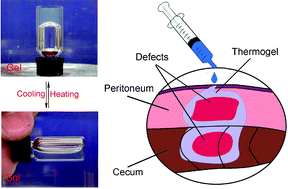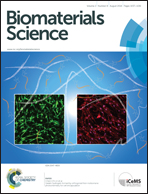Comparative studies of thermogels in preventing post-operative adhesions and corresponding mechanisms
Abstract
Post-surgical peritoneal adhesions constitute a classic problem in surgery, and thus anti-adhesion materials are much required. In this study, a series of polyester–PEG–polyester triblock copolymers with different biodegradable polyester compositions were synthesized, their properties were examined, and the in vivo efficacies as anti-adhesion biomaterials were evaluated in a comparative way for the first time. These samples not only exhibited various morphologies in the bulk state, but also possessed different stabilities in the sol state. All the polymer aqueous solutions with appropriate compositions and concentrations underwent sol–gel transitions with increase of temperature and formed semi-solid hydrogels at body temperature. The efficacy of PEG/polyester thermogels (25 wt%) for preventing post-operative abdominal adhesions was investigated and compared in a rabbit model of sidewall defect-bowel abrasion. Different efficacies of anti-adhesion were observed, possible mechanisms were discussed, and the importance of viscoelasticity was suggested for the first time. These results illustrated that appropriate properties of PEG/polyester thermogels including viscoelastic matrix, hydrophilic surface and moderate in vivo persistence played crucial roles in enabling an effective device to prevent post-surgical peritoneal adhesions.


 Please wait while we load your content...
Please wait while we load your content...